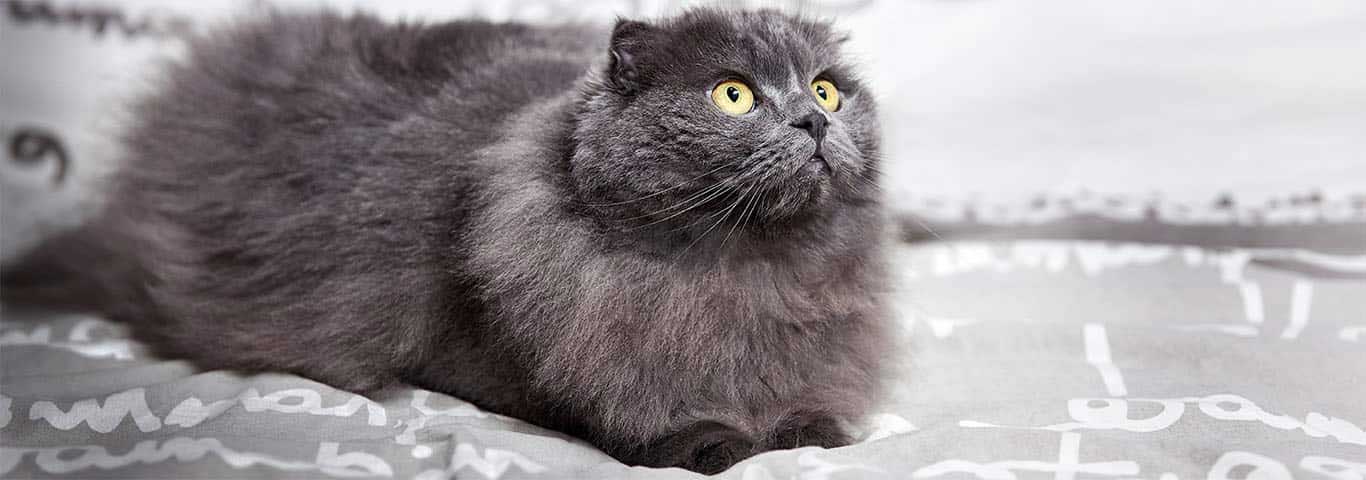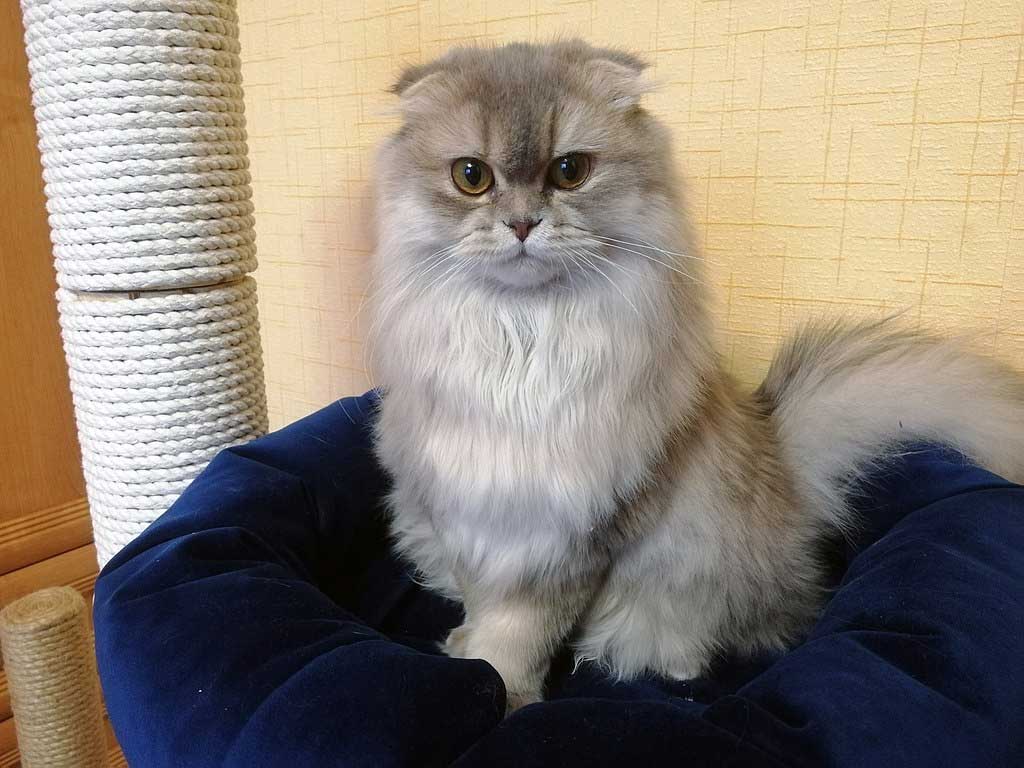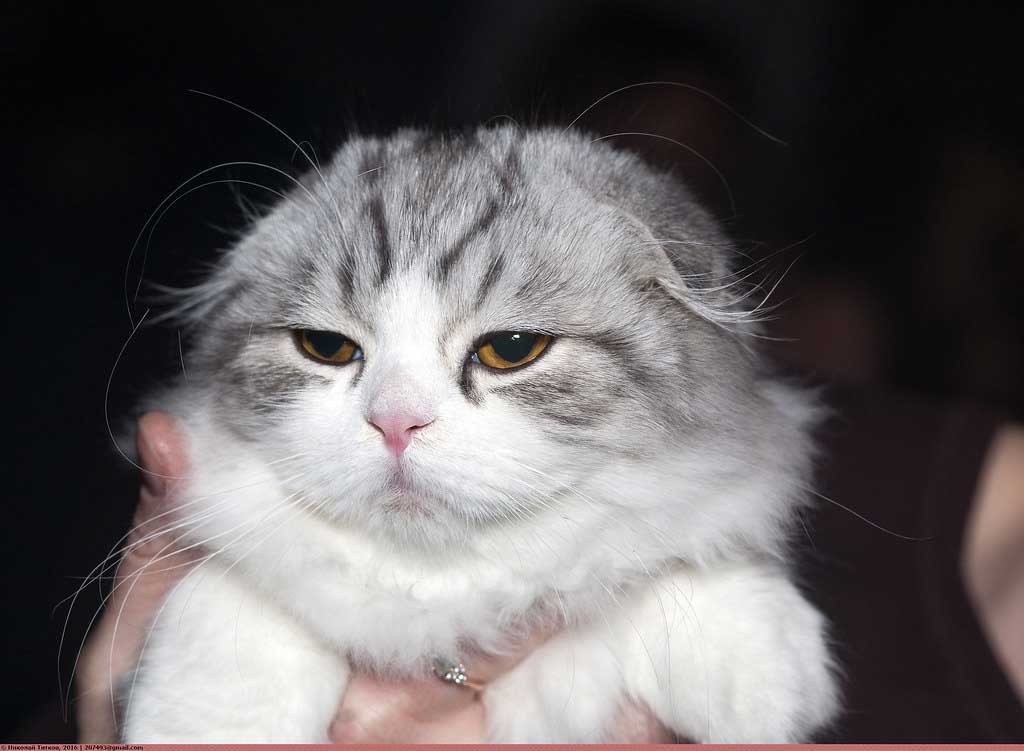
Content |
|---|
Characteristics "Highland fold cat"
Coexistence is important that you have with your new friend. Before considering the acquisition of a cat of the breed "Highland fold cat" you know certain factors. You must take into account their character, their need for exercise, their interaction with other pets, their care and if you have small children, their level of tolerance towards them.
Joy5.0 out of 5 stars (based on 1 review)
|
Activity level4.0 out of 5 stars (based on 1 review)
|
Friendliness to other pets4.0 out of 5 stars (based on 1 review)
|
|---|---|---|
Friendliness to children5.0 out of 5 stars (based on 1 review)
|
Grooming requirements5.0 out of 5 stars (based on 1 review)
|
Vocality1.0 out of 5 stars (based on 1 review)
|
Need for attention2.0 out of 5 stars (based on 1 review)
|
Affection towards its owners5.0 out of 5 stars (based on 1 review)
|
Docility4.0 out of 5 stars (based on 1 review)
|
Intelligence3.0 out of 5 stars (based on 1 review)
|
Independence4.0 out of 5 stars (based on 1 review)
|
Hardiness5.0 out of 5 stars (based on 1 review)
|
History
The history of Highland fold cat is inextricably linked to that of your partner, the Scottish fold, what is a Highland shorthair.
Their common ancestor appeared in 1961 in a little Scottish town called Coupar Angus, near the mountainous regions of the north of the country (the Highlands). Call Susie, this white cat with her ears folded forward is the origin of all cats Highland fold cat. He might have remained anonymous on the MacRae farm where he lived if a herdsman named William Ross hadn't noticed his distinctive ears.. In 1963 adopted Snooks, one of Susie's daughters, who also had white fur and folded ears.
But, folded ears in cats are nothing new. Specimens of this type had already been reported in the past., and already in 1796 John Hinton wrote in his Universal Knowledge Magazine about wild cats that lived in China and displayed such attributes.. In the 19th century, it is said that several sailors brought this type of cats from Asia, and in 1975, in his book The Guide to the Cats of the World, Loxton claimed that these forward-folding-eared cats had always existed in China..
But it was Susie and her daughter Snooks who originated the breed. Highland fold. In their first litter, Snooks gave birth to a male named Snowball - in reference to his white fur- which in turn was crossed with Lady May, a white short haired british. All five kittens from this union had folded ears., And so began the story of the Scottish fold.
Originally baptized as “Lops” by William Ross and his wife Mary, the breed was named after Scottish fold in 1966, cuando el Governing Council of the Cat Fancy (GCCF) granted it official recognition and allowed its exhibition in feline exhibitions, where it had a great success. At the same time, a breeding program was created.
But, the work done by various English geneticists, as Peter Dyte and Oliphant Jackson, revealed a relationship between curved ears and arthritis propensity in cats. Already concerned about the possible increased risk of ear infections and deafness caused by this anatomical feature (fears that were later proven unfounded), the GCCF decided on 1971 revoke your previous decision and, Therefore, stop accepting this breed.
In the news, the GCCF continues to maintain its position of not recognizing the Highland fold (nor its short-haired equivalent, the Scottish fold), arguing that the folded ears are due to a genetic mutation that is linked to potentially disabling bone problems for the animal. In this arbitration he had the support of the British Veterinary Association.
The salvation of the race came from the United States, Where, in 1970 The doctor. Neil Todd had imported three of Snooks' daughters to Newtonville, Massachusetts, to study their genetic mutations. But, he soon left his research project and one of these cats, called Denisla Hester, was hosted by Salle Wolf Peters, a cat breeder Manx.
Everything followed quickly, so that in 1972 the breed was presented at an exhibition organized by the Cat Fanciers’ Association (CFA), one of the leading organizations in the country. The interest was immediate and several breeders decided to develop the breed. The CFA supported them in their efforts and in 1974 allowed the registration of these cats as an experimental breed.
Aware of the risk of osteoarthritis associated with the genetic mutation that caused the folded ears, American breeders followed the recommendations of Dr.. Oliphant Jackson and brought new blood to the breed, crossing it abundantly with the American shorthair cat and the European shorthair cat (Common european cat), crosses that are still allowed today. This diversification effort paid off: arthritis cases decreased. In 1978, the CFA definitively recognized the Scottish fold. The TICA (International Cat Association) did the same the following year, in 1979.
From the beginning, long hairs have appeared in litters of Scottish fold, and Susie and her daughter Snooks were likely carriers of a recessive gene for long hair, that was passed on but could only be expressed if the kitten received another recessive gene for long hair. Probable crosses with the Persian Cat, as well as the crosses with the European shorthair cat (Common european cat) which in turn were the result of crosses with Persians, contributed other long-haired genes, so that individuals born with long hair became increasingly common.
From the years 80, began to arouse real interest and recognition from some organizations. But, even today, this recognition varies greatly between countries and cat organizations.
The CFA considers them as a simple variety of the Scottish fold, while the TICA grants them from 1979 full breed status, under the name of Scottish Fold longhair. On the other hand, some organizations do not recognize them at all, neither as a variety nor as a race. Is the case, for example, of the FIFé (Fédération Internationale Féline) and the British GCCF.
In France, the Livre Officiel des Origines Félines (LOOF) considers it as a separate breed, denominada Highland Fold. It also, the Highland fold without folded ears have also been recognized by the LOOF as a distinct breed since 2009, and they are registered as Highland Straight.
The Highland fold came to France in the decade of 1980, but it took time to become a success. In the early years of the 21st century, for example, there were still no more than fifteen registrations a year at the LOOF, and about forty at the end of his first decade. Then this figure grew exponentially until it reached about 250 copies a year ten years later. The Highland Straight, recognized only from 2009, experienced an even more spectacular increase, going from a score of individuals registered in the first year to almost 500 at the end of the Decade of 2010, that is to say, twice as much as him Highland fold.

Physical characteristics
The Highland fold it is a medium-sized cat with strong bones, looking agile and flexible despite her curvaceous body. The body is supported by legs relatively short and robust and is prolonged with a rather long and tapered tail that ends in a curve.
Its chin and their jaws well defined, as well as their cheekbones prominent, dan a su head a round shape. Their eyes, which are usually coppery in color but can be many other colors, especially blue in the case of white fur cats, they are also wide and round.
But it is the ears, short and rounded, the ones that make the famous Highland fold. Fall forward, folding in on themselves, hence the “Fold” of his name. They are also very mobile and expressive, being able to turn or straighten when lurking.
But, all kittens are born with straight ears, and only from 3 weeks start to double, at least some of them. Those who keep their ears straight are Highland Straight and can be crossed again with Highland fold: some of their descendants will have folded ears and, Therefore, will be Highland fold.
It also, the fur is what differentiates the Highland of the Scottish fold. While they both have a dense undercoat, the top layer of Highland fold is medium to long, with a silky texture. The throat, the breeches and the tail are very complete. According to the norm of Livre Officiel des Origines Félines (LOOF), all fur colors and patterns are allowed.
Last, the sexual dimorphism it is well marked, females being smaller than males.
Size and weight
- Male size: 23 to 28 cm.
- female size: 20-25 cm.
- Male weight: 4-6 kg
- female weight: 2,5-4 kg
Varieties of the "Highland fold cat"
Some feline organizations consider that the Highland fold it is simply a long-haired variety of the Scottish fold, not a breed in its own right.
On the other hand, the straight eared specimens are called Highland Straight and are considered a breed in their own right by various organizations, like the LOOF (Livre Officiel des Origines Félines) and the TICA (The International Cat Association), que lo denomina Scottish Straight longhair. Other associations recognize it as a variety, and others just don't recognize it at all.
Whatever your recognition, these cats are essential to the health of the breed Highland fold, as they can be bred with them to give birth to new cats with folded ears, while minimizing the risk of genetic diseases. Kittens born from such a union are carriers, at most, of a gene that causes this particularity, while those born from a mating between two Highland fold could carry this gene twice, situation leading to osteochondrodysplasia of varying severity.
Character and skills

It is also a breed of cat that adapts perfectly to children who know how to behave with animals, and enjoy receiving their attention. They are sociable and enjoy the company of other cats., as well as dogs used to cats, who can be excellent playmates for them. But, it is not advisable to try to live with rodents, reptiles or birds, as he will soon mistake them for prey.
To the Highland fold he likes company and easily suffers from loneliness. The presence of other animals is a great way to make the day go by when your family is working., and the extra attention at night helps make up for the fact that it has been neglected for several hours. But, this is not enough if you are absent for a long time. One Highland fold staying alone for a long weekend is likely to suffer from separation anxiety, which can lead to destructive behavior.
The Highland fold He is also known for his amazing poses: can be seen sleeping on his back, sitting on its hindquarters or standing on its hind legs. They also like to drink tap water instead of the fish tank., and some use their legs to eat.
They are incredibly agile, allowing them to pick up objects on the fly or open cupboard doors without difficulty. Skill games are a great way to keep your cat physically stimulated., while the various puzzles for cats help develop their intelligence.
Last, the Highland fold not heard often, and when it does, it is necessary to listen carefully, since his meow is very soft.
Grooming and caring for the "Highland fold cat"
The Highland fold it is a demanding breed of cat to maintain: its dense coat should be brushed two or three times a week to maintain its shine and prevent knots from forming.
It is also advisable to check your eyes and teeth weekly to avoid any risk of infection. You also have to pay special attention to the ears, which should be cleaned with a damp cloth.
Last, if natural wear and tear and the use of a scratching post are not enough for your claws and they become too long, must be trimmed with a nail clipper.
How much activity does he need? "Highland fold cat"?
Its moderate activity level makes it an ideal flat cat, but his family must not forget to play with him daily.
Health and nutrition
In general, the Highland fold it is a healthy breed of cat, to the point that many specimens have more than 15 years.
But, are more prone to certain diseases:
- The osteocondrodisplasia, which affects bone and cartilage development and can cause disabling osteoarthritis at an early age. The first symptoms are usually stiffness in the hind legs and/or tail;
- Hypertrophic cardiomyopathy, an abnormal enlargement of heart tissue that causes heart problems;
- The polykinetic kidney disease, a genetic disorder that causes numerous cysts in the kidneys, which can now be detected with a DNA test.
It is important to know that the breeding of two Highland fold it is prohibited by the different feline organizations. This is because the gene responsible for the folded ear mutation is dominant., that is to say, the kitten only needs to receive this gene from one parent to have this trait. But, all individuals carrying two mutated genes are affected by osteochondrodysplasia, to a greater or lesser degree. For this reason, miscegenation should be avoided at all costs Folds, and any breeder of Highland fold that does not respect this rule must be rejected.
The only options allowed are between a Fold and Straight (an identical cat with straight ears), a Fold and European shorthair cat (Common european cat), or a Fold and American shorthair cat. These crosses give rise to litters with a 50% kittens with folded ears.
It must be taken into account that the number of kittens per litter is usually lower than that of other breeds of cats..
Life expectancy
Of 12 to 15 years
Food
The Highland fold is not picky and does well with commercial cat food. But, These must be of good quality and adapted to your age and activity level to ensure that you receive the nutrients and vitamins you need.
How they are normally capable of self-regulation, they can have food available in their bowl at all times. But, check your weight at regular intervals to make sure you are not getting too fat, and you have to consult a veterinarian to establish a feeding program adapted to your needs if this is the case.
For sale "Highland fold cat"
The price of a kitten Highland fold it is on average about 1000 EUR.
But, this average hides large price differences between kittens with physical characteristics that are far from the standard, that can be found around the 500 EUR, and those whose prestigious lineage and characteristics predestine them for feline shows, whose price exceeds 2000 EUR.
In any case, there is no significant price difference between male and female kittens.
Videos "Highland fold cat"
|
Chat Highland Fold
|
Midori highland fold
|
|---|

with respect to the highlander breed, You can only get it at us.USA or Europe. in Latin America there are no breeders. just say that they are expensive as a preliminary race that is this stage of adoption in T.I.C.A. the first issue dates of the 2004. they might attempt in http://www.mundoanimalia.com There they get. Cheers